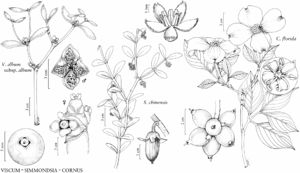Simmondsiaceae
Shrubs, evergreen, dioecious. Leaves opposite, simple; stipules absent; petiole present or absent; blade margins entire; venation pinnate. Inflorescences unisexual, axillary or terminal, glomerate cymes (staminate) or flowers usually solitary, rarely in 2–3-flowered clusters (pistillate). Flowers unisexual; perianth hypogynous; hypanthium absent; sepals (4–)5(–6), distinct; petals 0; nectary absent; stamens (8–)10(–12), distinct, free; anthers dehiscing by longitudinal slits; pistil 1, 3-carpellate; ovary superior, 3-locular, placentation apical-axile; ovule 1 per locule, apotropous; styles 3, distinct; stigmas 3. Fruits capsules, dehiscence loculicidal. Seeds 1(–3) per fruit.
Distribution
sw United States, nw Mexico, introduced in other regions.
Discussion
Species 1.
The status of Simmondsiaceae has long been controversial; it has previously been included in the Euphorbiales, either submerged in Buxaceae or as a separate family near Buxaceae (A. Cronquist 1981), or in the Hamamelidae as its own order (A. L. Takhtajan 1997). Recent molecular phylogenetic evidence supports recognition as a monogeneric family with a near-basal position in the Caryophyllales (P. Cuénoud et al. 2002; K. W. Hilu et al. 2003; Angiosperm Phylogeny Group 2003; S. F. Brockington et al. 2009).
